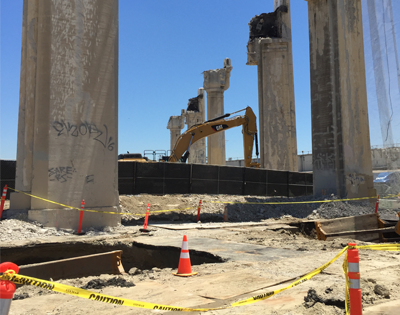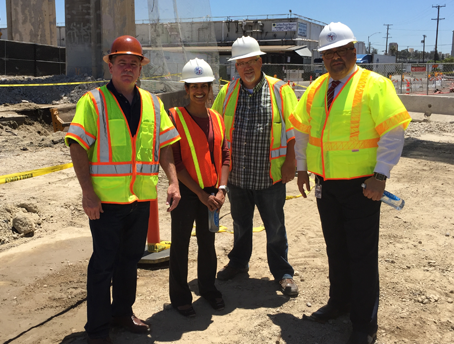Nov. 21, 2016 — Amid all the uncertainty in Washington D.C., Heal the Bay promises to keep a sharp eye on what a new administration means for our local environment, writes Dr. Rita Kampalath, Heal the Bay’s science and policy director.
UPDATE 2/1/17: Today members of the U.S. Senate Committee on Environment and Public Works boycotted the vote to confirm Oklahoma Attorney General Scott Pruitt’s nomination to lead the U.S. Environmental Protection Agency. A vote will be rescheduled in the coming days. Add your voice to this petition now urging the U.S. Senate Committee to reject Pruitt’s nomination. Tell our elected officials to maintain strong EPA funding for programs that affect our Bays nationwide.
While we’re still celebrating the tremendous wins that the California environment scored in the recent elections, we have been hearing voices of concerns from many Heal the Bay supporters about changes afoot on the national level. After months of campaign rhetoric, there’s a lot of uncertainty about the real-world policies and appointments rolling out from a new leader in the White House.
Given our 31-year role as a staunch defender of our local seas and watersheds, we’ve been paying particular attention to discussions about such topics as the purpose of the EPA and ongoing climate change policy. In my role of heading policy for an organization always guided by the best science, I’ve frankly been dismayed to hear opinions expressed by the new administration on some issues related to our core work. These initial reactions range from mildly concerning to truly alarming, given that some pronouncements are simply at odds with established scientific consensus. As a result, we’re going to be watching what goes on at the federal level closer than ever.
Below are topics our policy team will be keeping an eye on in the coming months as the new administration formalizes its course of action:
 Climate change: Despite the consensus of the vast majority of the scientific community that man-made climate change is very real, the issue remains a contentious topic for federal legislators, and a key policy area to watch going forward. The choice of a well-known climate change skeptic as leader of the EPA transition team has been disheartening, especially as Myron Ebell is also mentioned as potentially heading up the agency long-term.
Climate change: Despite the consensus of the vast majority of the scientific community that man-made climate change is very real, the issue remains a contentious topic for federal legislators, and a key policy area to watch going forward. The choice of a well-known climate change skeptic as leader of the EPA transition team has been disheartening, especially as Myron Ebell is also mentioned as potentially heading up the agency long-term.
The past few years have seen tremendous progress in the U.S. accepting our responsibility to take action for warming temperatures, highlighted by our ratification of the Paris Agreement last year. The incoming administration has expressed a clear stance on withdrawing the U.S. from this landmark agreement. This is obviously a global issue to be grappled with, but we have been working on climate resiliency with local municipalities for years. Rising seas, erosion, and flooding are very real possibilities on our shorelines in the not-too-distant future. But to fix the problem, we need to admit there is a problem.
 Energy: Strongly tied to U.S. actions on climate change are our energy policies in general, which may have additional impacts on natural resources and air and water pollution. Here on the California coast in particular, we’ll be watching out for any policies or actions that may open up our lands, in particular those offshore, to additional oil drilling and fracking. We’ll also look out for actions on recently adopted or still in the works policies such as the Clean Power Plan and mercury standards that seek to tighten standards on a range of air and water pollutants. These obviously have enormous potential impacts on the health of our local waterways and neighborhoods.
Energy: Strongly tied to U.S. actions on climate change are our energy policies in general, which may have additional impacts on natural resources and air and water pollution. Here on the California coast in particular, we’ll be watching out for any policies or actions that may open up our lands, in particular those offshore, to additional oil drilling and fracking. We’ll also look out for actions on recently adopted or still in the works policies such as the Clean Power Plan and mercury standards that seek to tighten standards on a range of air and water pollutants. These obviously have enormous potential impacts on the health of our local waterways and neighborhoods.
Clean Water Act: Last year, the EPA issued the Clean Water Rule (“Waters of the U.S.” rule), which clarified the definition of waters that are protected by the Clean Water Act. Thankfully, this definition recognizes the interconnectedness of waterbodies, and the impact that upstream waterbodies can have on navigable waters, and thus formalized protections for precious water resources such as certain wetlands and tributaries that previously may have been subject to debate. The new administration has made it clear that this rule will be a prime target for elimination.
Funding: Although it may be difficult to abolish entire agencies or programs completely, the power of the purse is no joke. We will be watching to see how funding of agencies, research, and grant programs related to the environment changes under the new administration. Certainly, the billion-dollar restoration plan of the L.A. River put forth by the U.S. Army Corps of Engineers will now be viewed through a new prism, leaving lingering questions about how the long-gestating project will now move forward.
New regulations: While we’re lucky to live in a state that is pretty consistently a leader in the nation on environmental laws, we’ll be vigilant for any federal regulations put forward that may seek to preempt state laws. While this approach may be beneficial in some instances where the federal law is more protective or establishes consistency among states, we’ll be wary of any attempts to limit the protections we as a state can ensure for our treasured natural resources.
 Infrastructure spending: Given the current degraded state of our infrastructure, Heal the Bay supports infrastructure spending and improvements. At the same time, we cannot set up a zero sum game between infrastructure and climate change as the new administration’s 100-day plan suggests. And infrastructure spending must be invested in projects that lead to more sustainable communities and incorporate best management practices in terms of energy and water use.
Infrastructure spending: Given the current degraded state of our infrastructure, Heal the Bay supports infrastructure spending and improvements. At the same time, we cannot set up a zero sum game between infrastructure and climate change as the new administration’s 100-day plan suggests. And infrastructure spending must be invested in projects that lead to more sustainable communities and incorporate best management practices in terms of energy and water use.
Heal the Bay was founded on the belief that, like the rights to free speech, equal treatment, to practice whatever religion you choose, and to love whomever you choose, we have a right to an environment that doesn’t pose a risk to our health and well-being. These rights and values are what make America great now! While we, as always, are rooting wholeheartedly for the success and forward progress of our nation, we believe that erosion of any of these rights is absolutely incompatible with any definition of success, and certainly any definition of progress.
Feeling like you want to take action in these uncertain times? We’ve got dozens of volunteer opportunities for you and your family.




 Climate change: Despite the consensus of the vast majority of the scientific community that man-made climate change is very real, the issue remains a contentious topic for federal legislators, and a key policy area to watch going forward. The choice of a
Climate change: Despite the consensus of the vast majority of the scientific community that man-made climate change is very real, the issue remains a contentious topic for federal legislators, and a key policy area to watch going forward. The choice of a  Energy: Strongly tied to U.S. actions on climate change are our energy policies in general, which may have additional impacts on natural resources and air and water pollution. Here on the California coast in particular, we’ll be watching out for any policies or actions that may open up our lands, in particular those offshore, to additional oil drilling and fracking. We’ll also look out for actions on recently adopted or still in the works policies such as the Clean Power Plan and mercury standards that seek to tighten standards on a range of air and water pollutants. These obviously have enormous potential impacts on the health of our local waterways and neighborhoods.
Energy: Strongly tied to U.S. actions on climate change are our energy policies in general, which may have additional impacts on natural resources and air and water pollution. Here on the California coast in particular, we’ll be watching out for any policies or actions that may open up our lands, in particular those offshore, to additional oil drilling and fracking. We’ll also look out for actions on recently adopted or still in the works policies such as the Clean Power Plan and mercury standards that seek to tighten standards on a range of air and water pollutants. These obviously have enormous potential impacts on the health of our local waterways and neighborhoods. Infrastructure spending: Given the current degraded state of our infrastructure, Heal the Bay supports
Infrastructure spending: Given the current degraded state of our infrastructure, Heal the Bay supports  We pulled up to the site, located where active construction is already going on – the highly publicized demolition of the 6th Street Bridge in Boyle Heights. The immediate rupture area was now cleared of the heavy machinery ever-present during the months-long razing of the iconic bridge, but I could still hear demolition crews working nearby. I couldn’t help but wonder if all this heavy construction nearby might have played a role in the failure of the sewer line.
We pulled up to the site, located where active construction is already going on – the highly publicized demolition of the 6th Street Bridge in Boyle Heights. The immediate rupture area was now cleared of the heavy machinery ever-present during the months-long razing of the iconic bridge, but I could still hear demolition crews working nearby. I couldn’t help but wonder if all this heavy construction nearby might have played a role in the failure of the sewer line.